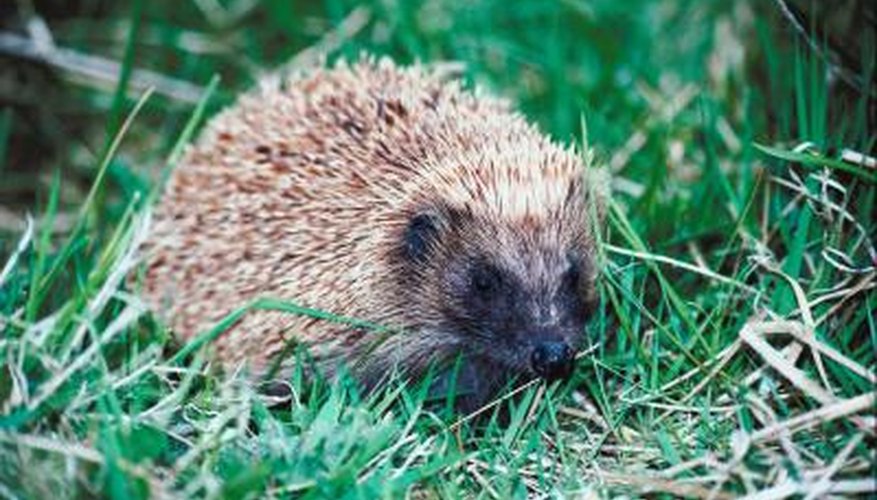Hedgehog adaptations help them to defend themselves from predators, such as foxes and badgers, and to hunt for their own prey. Hedgehogs are omnivorous, eating insects, snakes and frogs as well as plant matter. While their spines are clear physical adaptations, these animals also have behavioural adaptations that help them to thrive.
Spines
Hedgehogs usually have around 5,000 stiff, sharp, keratin-containing spines. The main purpose of these spines is to defend the hedgehog by deterring predators. However, the desert hedgehog, which has adapted to carry less heavy spines, sometimes uses them for attacking predators by charging at them. Hedgehogs display a behaviour known as anointing. This involves biting or licking items with strong scents or poisons, forming a paste with saliva and the new substance, and then flicking the paste onto its spines. Although the purpose of this behaviour is uncertain, it may protect the hedgehog from predators by disguising its own smell or cause an enemy to be poisoned if they come into contact with the spines. Other possible reasons include cleaning and protecting the animals from parasites. Hedgehogs are born with spines under their skin to protect the birth canal. Young hedgehogs shed their first set of spines and grow new, adult spines in a process called quilling.
- Hedgehogs usually have around 5,000 stiff, sharp, keratin-containing spines.
- This involves biting or licking items with strong scents or poisons, forming a paste with saliva and the new substance, and then flicking the paste onto its spines.
Curling into Balls
If a hedgehog senses danger and cannot run away fast enough, it is able to curl itself up into a ball. It achieves this by having a large amount of loose skin, particularly on its back, and stronger, tighter muscle and skin connections on its sides. A strong muscle, which helps the animal to curl up, is located beneath the loose skin on the hedgehog's back. In a curled position, spines stand out to deter predators and protect the hedgehog.
- If a hedgehog senses danger and cannot run away fast enough, it is able to curl itself up into a ball.
- A strong muscle, which helps the animal to curl up, is located beneath the loose skin on the hedgehog's back.
Hibernation
Hedgehogs in colder climates survive winter by hibernating. To prepare for hibernation, hedgehogs build up fat stores as a source of energy. These animals are capable of reducing their body temperature, heart rate and metabolism dramatically during hibernation, enabling them to conserve energy.
Nocturnal Adaptations
Hedgehogs are generally nocturnal. Although their eyesight is weak, other senses that help them to forage at night are more developed. Hedgehogs rely upon their strong senses of hearing and smell. The hedgehog's protruding snout is very sensitive and mobile, allowing it to search for prey through undergrowth. Hedgehogs usually forage for food, such as insects and vegetation, at night when it is more difficult for predators to see them. While sleeping during the day, these animals protect themselves from predators by assuming the curled-up position.
- Hedgehogs are generally nocturnal.
- The hedgehog's protruding snout is very sensitive and mobile, allowing it to search for prey through undergrowth.
Legs and Paws
Hedgehogs have strong rear legs with thick, long claws at the ends of their toes. These help the hedgehog to dig, particularly when creating an underground den for its hibernation period. The paws and nails on the hedgehog's front legs are weaker. This animal is also able to use its legs and paws to swim and climb effectively.
- Hedgehogs have strong rear legs with thick, long claws at the ends of their toes.
- The paws and nails on the hedgehog's front legs are weaker.
